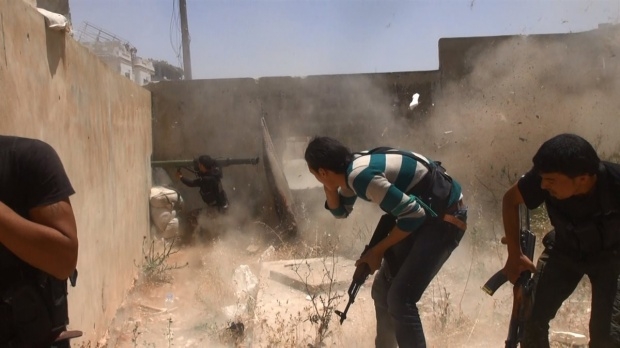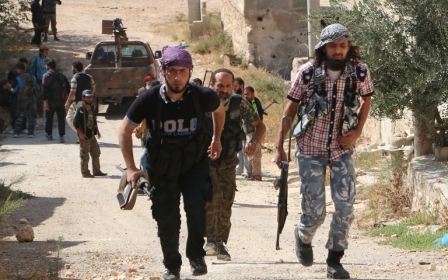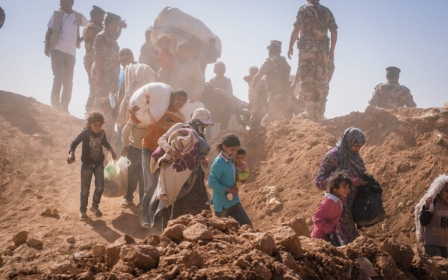Spirit of the south: a reconfigured Free Syrian army rises in Dera’a

It has scarcely been a week, but already the poetically named military operation ‘Dawn and Ten Nights’ has delivered remarkable results for southern Syria’s beleaguered rebels.
After 36 hours of heavy fighting that began over the Eid al-Adha holiday, the hilltop regime station of Tal al-Harah, the highest point in Dera’a, is in rebel hands. Inside the station was a trove of Russian and Iranian weapons and ammunition, as well as tanks, cars, radar devices and signal jamming equipment.
The base was well known to anyone who had completed their military service as a highly important spy station, said a former government soldier with a reconnaissance unit. On a clear day, you could see over the Golan and into Israel from Tal al-Harah – and surveillance equipment made it possible to listen to Israeli military radio, too.
What was less well known is who was using it: the walls of the station were covered in Russian-language maps of the region. The former soldier confirmed to Middle East Eye that this strategically located base was the jewel in the crown of a now-defunct Russian-led spy programme run out of Syrian military bases. He said the programme had wound down as the civil war picked up, and rebels who fought at Tal al-Harah confirmed no Russians were seen on site.
Though Tal al-Hara may no longer serve as an active international spy nest, it was an effective way for the regime to monitor rebel movements in rural Dera’a, Quneitra and the countryside south-west of Damascus. In videos and photos posted to social media this week, jubilant rebels are shown racing uphill to the newly sacked base and driving away with truckloads of heavy and light weapons. It’s clear this was a significant victory.
It’s also a victory that came uncomfortably late in the game. The southern rebels have spent much of the past year on the back foot, reeling from one Syrian government offensive to another, bickering with their supposed allies and crying out for guns, training and money from Western and Saudi backers.In Dera’a the two most dominant rebel groups, the secular-ish FSA and the al-Qaeda franchise Jabhat al-Nusra, recently overcame ideological differences and a sea of bad blood to work together against their common enemy, Syrian President Bashar al-Assad.
‘Dawn and Ten Nights’ applies the principle of ‘ikhwan’ – or brotherhood - as many of the fighters refer to their new team of sorts. The ongoing operation includes rebels from 92 factions, from the secular to Islamist militants. For the first time, fighters from the Syrian Revolutionaries Front, an FSA alliance, are answering to the same control room as the Islamic Front and Jabhat al-Nusra. This is an enormously significant development: while in Aleppo, Reef Damascus, Hamas and other rebel hotspots these different groups maintain a cautious détente or a quiet mutual acknowledgement, only in Dera’a have they managed to work together – and actually deliver results.
Rebels refuse to say how long it took to negotiate the collaboration, but the effort, said FSA field commander Abu Farouq, was worth it: “We welcome this cooperation and we hope to continue cooperation between all of these factions. It has brought us great success in a short time.”
Locals say working towards a shared goal is characteristic of Dera’a, a rural, conservative province of about 1.3 million that stretches across the Houran Plain, which straddles Syria and Jordan. Family comes first here, and tribal ties are binding and extensive.
Though Dera’a is mostly Sunni, high-ranking government positions are occupied by Alawites, who are closer to the government. The spark of protest that blazed into civil war traces back to Dera’a, where a group of children scrawled an anti-regime taunt on a wall and were tortured by the authorities for their act of defiance. Much of the province rallied around those boys and their families, rage eventually coalescing into a cry for revolution and an armed opposition willing to fight for it. Some of the first officers to defect from the Syrian government were from Dera’a, and they created the FSA.
This cultural context is crucial to understanding how the spirit of rebellion has lasted so long in the south: even as the country is torn apart by competing factions, in Dera’a the talk is of revolution, not civil war. The Houranis still believe.
Ostensibly, their American and Saudi allies believe in them, too. The Saudis have long backed arming the rebels based in the south and, in September, the US green-lit a $500 million effort to overtly train and arm what they refer to as "moderate" Syrian rebels to fight against Islamic State militants (after covertly offering the same support to rebels fighting against Assad for several years). But material support is slow in coming.
“This three-way equation makes strategic planning difficult. It’s not clear how far the Saudis will go, but they’ve been demanding the US do something about Assad and not just IS – this was their price for joining the coalition,” said Michael Stephens, an analyst with the Royal United Services Institute think tank in London.
The American view on the so-called southern ikhwan is similar, said Washington Institute analyst Andrew Tabler. “FSA units are continuing to coordinate with Jabhat al-Nusra and others out of necessity to successfully push Assad back. But that doesn't make it any easier for the US to train and equip Syrian rebels.”
Israel also has an interest in what happens in Dera’a, especially when it comes to rebel groups it can use as a buffer against the Islamic State, which is a real, if not yet realised, threat to the south.
Israeli political commentator Ehud Yaari said Israel had provided arms to some rebel groups including Jabhat al-Nusra, underscoring the possibility of ends-means collaboration between erstwhile enemies. Still, he said, Israeli interests are limited: “If the US is serious about training and arming moderate rebels, the Quneitra-Dera’a region would be a good place to do it. Israel and Jordan can help, but they wouldn’t intervene militarily.”
Just as non-intervention drove feuding rebel groups together, intervention might drive them apart. For Stephens, who has been watching the south closely, the key question is who gets what weapons and in what quantities.
“It’s difficult to see how ISIS and Nusra won’t benefit if the plan doesn’t work out. And what is the plan? The Saudis want Assad gone, I’m not sure the US does. So weapons will be limited, which causes friction,” he said.
“The problem, in my view, is that if this much vaunted drive to unify the rebels fails, who will the rebels turn to?”
The stakes are high, say activists: if the opposition fails in the south, where its roots go deepest and its pull is strongest, it will fail in all of Syria. But in the victorious afterglow of Tal al-Harah, few rebels are asking the hard questions. Abu Farouq, the FSA field commander who fought in the battle for the hill and continues to to fight alongside his former adversaries, raved about the collaboration: “This is a quantum leap for action and cooperation across all factions and battalions in Dera’a and Quneitra. It gave us unity, and the more that unites us, the greater our successes and our progress.”
And the rebels are progressing. In the days following the Tal al-Halah operation, rebels fanned out into the villages around the hill, consolidating their gains.
On Friday, rebels had turned their guns on the government troops in Dera’a city, where the two sides have been locked in stalemated battle for more than a year. Activists say they are hopeful of progress on the ground, but they admit the regime still owns the skies, dropping barrel bombs from helicopters and ordnance from fighter jets.
It’s the long view that’s difficult to see, and this makes Stephens uneasy.
“For now, the regime seems to have been pushed back. My worry is that if they counter attack again and the rebels struggle, the rebels will look for more drastic support,” he said.
Adding more players and more agendas to an already delicate union would upset the balance that has enabled recent rebel gains. It would likely lead to greater infighting and loss of life on all sides, dragging the war out. But even if the balance can be held and the goal of defeating Assad achieved, what then? In a war with so many players, and even more shadowy backers stoking age-old regional and sectarian conflicts by proxy, the possible outcomes are myriad – and, for the civilians caught in the middle, terrifying.
“The other issue is that if the regime is beaten in the south, can the rebels hold onto it?” asked Stephens. “If I was Islamic State, I’d look at that area as easy pickings.”
Middle East Eye propose une couverture et une analyse indépendantes et incomparables du Moyen-Orient, de l’Afrique du Nord et d’autres régions du monde. Pour en savoir plus sur la reprise de ce contenu et les frais qui s’appliquent, veuillez remplir ce formulaire [en anglais]. Pour en savoir plus sur MEE, cliquez ici [en anglais].




